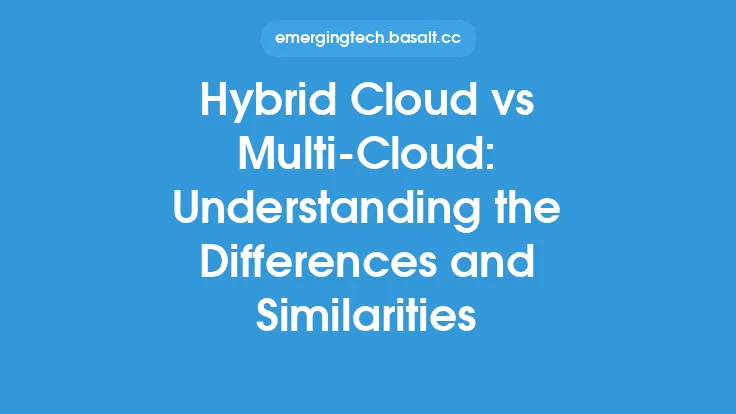The relationship between cloud infrastructure and virtualization is a fundamental concept in the realm of cloud computing. Cloud infrastructure refers to the underlying systems and resources that enable cloud computing, including servers, storage, networking, and software. Virtualization, on the other hand, is a technology that allows multiple virtual machines (VMs) to run on a single physical machine, sharing its resources. In this article, we will delve into the intricacies of the relationship between cloud infrastructure and virtualization, exploring how they intersect and complement each other.
Introduction to Virtualization
Virtualization is a key enabler of cloud infrastructure, as it allows cloud providers to maximize resource utilization, increase efficiency, and improve scalability. By creating multiple VMs on a single physical machine, virtualization enables cloud providers to offer a range of services, including infrastructure as a service (IaaS), platform as a service (PaaS), and software as a service (SaaS). Virtualization also provides a layer of abstraction between the physical hardware and the virtual machines, making it easier to manage and maintain cloud infrastructure.
How Virtualization Supports Cloud Infrastructure
Virtualization supports cloud infrastructure in several ways. Firstly, it enables cloud providers to create multiple virtual machines on a single physical machine, which can be used to support different applications, services, or customers. This allows cloud providers to maximize resource utilization, reducing the need for physical hardware and minimizing waste. Secondly, virtualization provides a high degree of flexibility, allowing cloud providers to easily scale up or down to meet changing demand. This is particularly important in cloud computing, where resources may need to be rapidly provisioned or de-provisioned in response to changing business needs.
Types of Virtualization
There are several types of virtualization, including server virtualization, storage virtualization, and network virtualization. Server virtualization is the most common type of virtualization, and involves creating multiple virtual machines on a single physical server. Storage virtualization, on the other hand, involves creating a virtual layer of storage that can be used to manage and allocate storage resources. Network virtualization involves creating virtual networks that can be used to manage and allocate network resources. Each type of virtualization plays a critical role in supporting cloud infrastructure, and is used to create a range of cloud services.
Virtualization and Cloud Infrastructure Architecture
The architecture of cloud infrastructure is closely tied to virtualization. Cloud infrastructure typically consists of a large number of physical servers, storage systems, and networking equipment, which are used to support a range of cloud services. Virtualization is used to create a layer of abstraction between the physical hardware and the cloud services, making it easier to manage and maintain cloud infrastructure. The use of virtualization also enables cloud providers to create a range of cloud services, including IaaS, PaaS, and SaaS, which can be used to support different applications and use cases.
Benefits of Virtualization in Cloud Infrastructure
The use of virtualization in cloud infrastructure provides a range of benefits, including increased efficiency, improved scalability, and enhanced flexibility. Virtualization enables cloud providers to maximize resource utilization, reducing the need for physical hardware and minimizing waste. It also provides a high degree of flexibility, allowing cloud providers to easily scale up or down to meet changing demand. Additionally, virtualization provides a layer of abstraction between the physical hardware and the cloud services, making it easier to manage and maintain cloud infrastructure.
Challenges and Limitations of Virtualization in Cloud Infrastructure
While virtualization provides a range of benefits in cloud infrastructure, there are also several challenges and limitations to consider. One of the main challenges is the complexity of virtualization, which can make it difficult to manage and maintain cloud infrastructure. Additionally, virtualization can introduce additional overhead, which can impact performance and efficiency. There are also security concerns associated with virtualization, as virtual machines can be vulnerable to attack. Finally, there are limitations to the scalability of virtualization, which can impact the ability of cloud providers to meet changing demand.
Best Practices for Implementing Virtualization in Cloud Infrastructure
To get the most out of virtualization in cloud infrastructure, there are several best practices to follow. Firstly, it is essential to carefully plan and design the virtualization architecture, taking into account the specific needs and requirements of the cloud services. Secondly, it is important to choose the right virtualization technology, considering factors such as performance, scalability, and security. Thirdly, it is essential to implement robust management and monitoring tools, to ensure that virtualization is properly managed and maintained. Finally, it is important to consider the security implications of virtualization, and to implement robust security measures to protect against attack.
Future of Virtualization in Cloud Infrastructure
The future of virtualization in cloud infrastructure is likely to be shaped by several trends and technologies, including the increasing adoption of cloud-native applications, the growing use of containers and serverless computing, and the development of new virtualization technologies such as nested virtualization. Additionally, there is likely to be a greater focus on security and compliance, as cloud providers seek to protect against increasingly sophisticated cyber threats. As cloud infrastructure continues to evolve, it is likely that virtualization will play an increasingly important role, enabling cloud providers to create more efficient, scalable, and flexible cloud services.
Conclusion
In conclusion, the relationship between cloud infrastructure and virtualization is a complex and multifaceted one. Virtualization is a key enabler of cloud infrastructure, providing a range of benefits including increased efficiency, improved scalability, and enhanced flexibility. However, there are also several challenges and limitations to consider, including complexity, overhead, security concerns, and limitations to scalability. By following best practices and staying up-to-date with the latest trends and technologies, cloud providers can get the most out of virtualization, and create cloud infrastructure that is efficient, scalable, and secure. As cloud computing continues to evolve, it is likely that virtualization will play an increasingly important role, enabling cloud providers to create more efficient, scalable, and flexible cloud services.





